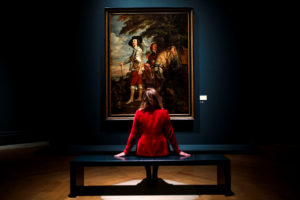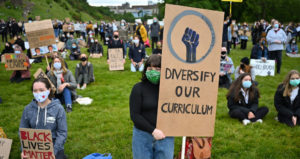In 1906, the New York Times reported on a new exhibition at the monkey house in the Bronx zoo causing a stir among visitors and the press: a human inhabitant. Ota Benga, a 23-year-old Bushman, could be seen in the orang-utan enclosure, where he drew crowds of hundreds who stared at him as he wove hammocks or shot his bow.
This was an age far more gung-ho than our own about taking artefacts, creatures and even living human beings from their contexts, and putting them on display for the entertainment and edification of the masses. Prince Albert’s 1851 Great Exhibition had displayed technological innovations alongside consumer goods and looted colonial treasures, setting off a trend for World Fairs that served both in person and via print media as a kind of populist catalogue of all there is to know about the world. Museums of all kinds flourished over the same era as standard-bearers for culture across Europe and the New World.
But is it intrinsically wrong to display things — or people — in this way? Even in 1906, caging a living human in a monkey enclosure prompted outrage. Since then, though, our discomfort with the objectification this implies has grown much more intense. “What’s the point of museums?” asked the Wellcome Collection recently on Twitter. This was a preamble to announcing the closure of the Wellcome Trust’s Medicine Man exhibition, a large collection of medical artefacts from around the world that had been amassed by the American pharmaceutical entrepreneur Henry Wellcome through the late 19th and early 20th centuries.
The announcement prompted a furious response, denouncing the move as “infantile and anti-intellectual” and modern museums as “vandalising themselves”. And it’s true that the economic and political power that allowed museum collections to be amassed has come under revisionist scrutiny more recently — as has the worldview that gave rise to museums as a cultural form. The turning-point was the First World War, the conflagration that destroyed high imperial Europe, and set in motion the disintegration of its empires in favour of the Pax Americana we’ve all inhabited since.
More than a century after that hinge moment, today the worldview and geopolitical order that amassed most of our museum collections are denounced as “problematic” — and increasingly subject to “dismantling”. But rather than merely complain, yet again, about “woke” culture war being waged in museums, we should see that the assault this implies on an entire worldview — Enlightenment objectivity — is not without justification. Nor is the “dismantling” of this worldview something that can be halted. But the ongoing assault on what’s left of our 19th-century cultural heritage is less a reflection of moral progress in any absolute sense, than of shifts in the underlying power relations that gave rise to museums in the first place.
In their classical 19th-century form, museums and exhibitions are the quintessential “pop” expression of the Enlightenment worldview. To present something as an exhibit in a museum makes a statement about that thing, and what we can know about it.
It says: I, the curator, am in command of what’s knowable about this thing, which you observe from a distance while absorbing facts about it. A museum’s traditional spatial arrangements underline the core empiricist relation between observer and observed. You aren’t free to touch or use or otherwise form a tactile relationship with the artefacts on display. Instead, visitors are invited to observe exhibits from a distance, while absorbing curated facts about them. By extension, the museum implies, this is how civilised people relate to the world in general.
And to make sense in this context, the exhibit must be removed from the network of social relationships that produced it, and rendered as a thing: a discrete object. So what, you might say. What’s wrong with looking at things, in order to learn about the world? But the revulsion occasioned by Ota Benga’s appearance in the Bronx Zoo in 1906 suggests that it isn’t just “woke” modern-day curators who sense that something violent, or violating, happens when an “exhibit” is removed from its social context and placed on display: a literal objectification, made only starker when it happens to a living person.
This perspective argues further that it’s not just the act of turning artefacts into exhibits that both enacts, and conceals, violence. And this core of the woke critique of this social form is the same as its critique of rationalism more generally: that it obscures its own power relations.
For even when they’re presented as high-minded repositories of knowledge, under the bonnet museums hold the residue of much else besides. Museums encode a hierarchical power relation between observer and exhibit, and another secondly between curator and visitor. In their 19th-century form, museums also collated the edited highlights of the entire civilisational order of high colonial Europe, while downplaying the real-world power, money and sometimes bloody violence that went into creating that order. In his 2020 polemic The Brutish Museums, Pitt-Rivers curator Dan Hicks argues that far from being a benign side-effect of imperialism, museums are in fact inextricable from that violence — and that for as long as museums exist, they’re still perpetuating it.
Hicks cites as a central example the Benin bronzes, which were looted from a destroyed city in what is now Nigeria, following the Punitive Expedition in 1897, during which Benin was destroyed and its inhabitants massacred. Though today negotiations are ongoing about returning them to Nigeria, some 900 of the bronzes remain in the British Museum, where they were displayed for many years with little commentary on their provenance.
The British Museum is also under ongoing pressure to return the Greek sculptures taken from the Parthenon between 1801 and 1812 by Thomas Bruce, the Earl of Elgin. Their removal was controversial even at the time, and Elgin eventually backed out of the controversy by selling the sculptures to the British government. Like the Benin bronzes, they now reside in the British Museum, where they have become a bone of diplomatic contention between Britain and Greece.
So museums serve as powerful sociocultural force-fields. They collate objects taken sometimes forcibly, while entrenching some ideas as “facts” and normalising the invisibility of other, equally salient ideas, along lines that align with the dominant political order. But the woke critique tends to stop here, rather than noticing that this cuts both ways. Wherever we find museums — or their exhibits — obviously under attack in the modern world, this tends to correspond to wider shifts in power relations; for example modern Greece has been complaining about removal of the Elgin Marbles since the state was founded in the 19th century. But Greek diplomats didn’t start seriously campaigning for their return until some time after the collapse of Britain as a global geopolitical hegemon.
Meanwhile, Dan Hicks has provided a furious text to accompany the Wellcome Collection’s exhibit of Jeremy Bentham’s skin, in which Hicks denounces the way museums “recentred the white cis-male body” and demands that curators “Dismantle Wellcome’s enduring colonialism, its white infrastructure”. But what this perhaps ignores is that we could dispose of Wellcome’s entire collection of artefacts, and doing so wouldn’t make the smallest dent in the Wellcome Trust’s contribution to the objectifying worldview at the heart of woke critiques of museums as such.
Henry Wellcome made his money in pharmaceutical innovation, a success founded in the scientific paradigm: a worldview even more quintessentially objectifying and rationalist than the architecture of a traditional museum. Museums extend this worldview beyond the sciences, implying that this is what “learning” is: a detached, observing consciousness standing at a little distance from an object whose meaning is contained on a little sign. And if you were taking serious aim at the “violence” encoded in that rationalism, you would have to be willing to sacrifice all of the natural sciences too.
But the Wellcome Trust isn’t doing that. The rationalism encoded in scientific research is still generously funded by Wellcome Trust grants, even as the same worldview is loudly “contextualised” in the same foundation’s museum exhibits. So regardless of how loudly the surface colouring is denounced by Dan Hicks, the institution’s plumbing and associated worldview have been left more or less intact, with little more than a change of surface colouring.
Objectors might point out that the war on science is indeed happening in some contexts, for example where Scientific American and Nature publish pieces arguing that “sex is a spectrum” (it really isn’t a spectrum). But it’s also true that scientists remember there are two sexes again the moment there’s money to be made from the fertility industry.
And this, ultimately, is why woke museum revisionism excites anger: the sense that power relations are less being “dismantled” than redecorated, in the name of a new and just-as-mystified set of power relations. And we can infer from this that calling progressives “anti-culture” is to underestimate this worldview.
Some of those challenging the objectification baked into the museum format are no doubt genuine in their wish to give voice to marginalised perspectives. But no matter how you rail against the past, how many angry footnotes you add to an exhibit, or even if you abolish museums altogether, you can’t really undo historic power relations. Nor does rescuing “objectified” artefacts even necessarily reinstate them in the context from which they were taken. Ota Benga ended up being “rescued” by Black Baptists, who took him to Virginia and gave him a room and board. But he was never happy living in a house, and would often sleep in the woods. Homesick for the Congo, eventually he built a bonfire, burned the European clothes in which he’d been dressed, and shot himself.
By the same token, while the artefacts in the Wellcome Collection aren’t sentient human beings, it’s not as though being “contextualised” afresh in light of the new morality will make any substantive difference to their previous history, or result in their restitution wherever they came from. Nor would it make any difference to the wider paradigm of scientific rationalism whose advance continues to be funded by the legacy of Henry Wellcome. All that would change would be the aesthetics that decorate that advance.
Those who set the limits on what can or can’t be “problematised” know this. They will merrily smash every legacy of high European imperialism, in the name of ending oppression — except where that legacy is still useful. And this is not any kind of “dismantling’”; it’s simply new owners redecorating an economic and political engine, which will go on operating largely untouched. In other words: it’s not moral progress, it’s just a change of management.
Disclaimer
Some of the posts we share are controversial and we do not necessarily agree with them in the whole extend. Sometimes we agree with the content or part of it but we do not agree with the narration or language. Nevertheless we find them somehow interesting, valuable and/or informative or we share them, because we strongly believe in freedom of speech, free press and journalism. We strongly encourage you to have a critical approach to all the content, do your own research and analysis to build your own opinion.
We would be glad to have your feedback.
Source: UnHerd Read the original article here: https://unherd.com/





